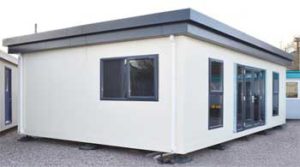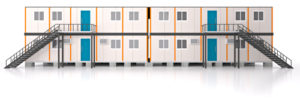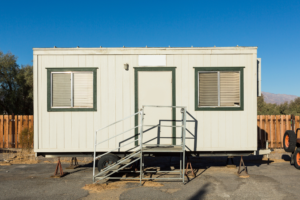
Portable buildings have become an increasingly popular option for those looking for extra space on their property. However, many people are unaware of the various factors that contribute to the total cost of these structures. In this blog, we’ll explore the different components that make up the cost of a portable building and provide tips on how to get the most bang for your buck.

Material Costs
One of the most significant expenses associated with portable buildings is the cost of materials. The type of materials you choose, such as wood, metal, or plastic, will significantly impact the overall cost. Additionally, factors such as the thickness of the walls, the type of roof, and the number of windows will all play a role in determining the material costs. Some common materials used for portable buildings include:
- Wood: $6-$14 per square foot
- Metal: $10-$20 per square foot
- Plastic: $8-$15 per square foot
- Vinyl Siding: $2-$7 per square foot
- Aluminum Siding: $4-$12 per square foot
Labor Costs
The cost of labor is another factor to consider when determining the total cost of a portable building. This includes the cost of hiring a contractor to install the building, as well as any associated costs such as permits and inspections.
To save money on labor costs, consider doing some of the work yourself, such as installing the windows or laying the foundation. On average, labor costs can range anywhere from 10-20% of the total cost.

Delivery and Installation Costs
In addition to the cost of the building itself, there are also delivery and installation costs to consider. These costs will depend on the size of the building, the distance it needs to be transported, and the difficulty of the installation process. To save money on these costs, consider purchasing a building that is close to your location and can be easily assembled.
Accessories and Upgrades
Another factor that can impact the cost of a portable building is the cost of accessories and upgrades. This includes items such as shelving, air conditioning units, and electrical upgrades. While these additions can make your building more comfortable and functional, they can also significantly increase the overall cost. Consider prioritizing your needs and only purchasing upgrades that are essential to your use of the building.

The cost of a portable building can vary greatly depending on a variety of factors. By understanding the different components that contribute to the total cost, you can make informed decisions about your purchase and find ways to save money. With a little research and planning, you can find a portable building that meets your needs and fits your budget.
How Much Do Portable Buildings Cost?
The cost of portable buildings can vary greatly, depending on factors such as size, material, and location. However, the price can quickly escalate if you opt for larger buildings, higher-quality materials, or add accessories and upgrades. The price may also vary depending on whether you choose to rent or buy a portable building.
- On average, a small, basic portable building can cost anywhere from $3,000 to $7,000.
- For example, a larger building made of high-end materials such as metal or heavy-duty plastic can cost anywhere from $10,000 to $25,000 or more.
- The cost of delivery and installation can also add several thousand dollars to the total cost.
- It’s also important to consider the cost of any necessary permits, inspections, or foundation work, which can add to the overall cost of the building.

In summary, the cost of a portable building can range from a few thousand dollars to several tens of thousands of dollars, depending on the size and materials. To get a more accurate estimate of the cost, it’s best to get quotes from several different suppliers and compare the prices and features of their offerings.
The Pros and Cons of Portable Buildings
There are several pros and cons to portable buildings that need to be taken into consideration when deciding whether they are the right option for your needs.
Pros of Portable Metal Buildings:
- Durability:
Portable metal buildings are built with heavy-duty materials that are designed to withstand harsh weather conditions and last for a long time. They are resistant to fire, rot, and pests, making them a low-maintenance option for storage and other uses.
- Affordability:
Compared to traditional construction methods, portable buildings are often more affordable. This is because they are manufactured in a controlled factory setting, reducing the need for on-site labor and materials.
- Versatility:
Portable buildings can be used for a variety of purposes, including storage, workshops, offices, and even living spaces. They can also be customized to fit specific needs and requirements.
- Ease of Assembly:
Portable buildings can be assembled quickly and easily, often with just a few people and basic tools. This makes them a convenient option for those who need a building in a hurry or who want to save on labor costs.

Cons of Portable Metal Buildings:
- Limited Design Options:
While portable buildings can be customized, they may not offer the same level of design flexibility as traditional construction methods. This can limit the building’s aesthetic appeal and make it difficult to blend in with surrounding structures.
- Poor Insulation:
Portable buildings can be drafty and may have limited insulation options. This can make them uncomfortable to use in extreme temperatures.
- Limited Resale Value:
Portable buildings may not have the same resale value as traditional buildings, as they are often seen as less permanent and less desirable.
Portable metal buildings can be an affordable and versatile option for those in need of extra storage or a workspace. However, it’s important to consider the limitations and drawbacks before making a purchase. With a little research and planning, you can find a portable building that meets your needs without breaking the bank.

Top 10 Unique Uses for Portable Metal Buildings
Metal buildings are experiencing a resurgence in popularity, owing to their durability, ease of assembly, and the flexibility they provide for a range of uses. No longer solely seen as just storage spaces or industrial warehouses, the potential applications for these portable structures are virtually endless. In this guide, we’ll explore the top 10 unique uses for portable metal buildings.
1. Tiny Home
Metal buildings can easily be converted into livable spaces. Their durability and robustness make them perfect for creating a cozy and minimalist tiny home. These tiny homes can be constructed faster and are more affordable than their traditional counterparts. It’s an excellent solution for those looking to downsize or seeking an affordable housing option.
2. Storage Shed
One of the most common uses for metal buildings is as a storage shed. With the ability to customize the interior, these buildings can be adapted to store anything from garden tools and bicycles to outdoor furniture and more. It’s a reliable and weather-resistant alternative to wooden storage sheds.
3. Garden Shed
Portable metal buildings make an excellent portable shed. They provide ample space for storing gardening tools, potting supplies, and even feature room for a small greenhouse. The metal structure is resistant to pests and moisture, keeping your gardening supplies safe and dry.
4. Home Office
With the rise of remote work, creating a separate workspace has become increasingly important. A metal building can serve as a home office, offering a dedicated space away from household distractions. It can be outfitted with all the necessary office equipment and decorated to inspire productivity.
5. Workshop or Art Studio
Whether you’re a hobbyist or a professional, a portable metal building can be transformed into a workshop or art studio. The space can be customized to suit the nature of your work, whether it involves heavy machinery, or delicate canvases.
6. Personal Gym
Why pay for a gym membership when you can build a personal fitness center in your backyard? With adequate space for exercise machines and weight racks, a portable metal building can be the perfect solution for health enthusiasts seeking the convenience of working out at home.
7. Metal Garages
With the ability to custom-fit large doors, a portable metal building can serve as a secure, weather-proof garage for vehicles, boats, or RVs. These structures can also offer additional space for workbenches or storage.
8. Event Space
Need a venue for a party, wedding, or community gathering? A large metal building can be dressed up to host a variety of events. It offers a blank canvas that can be decorated according to the theme of your event.
9. Retail Store or Pop-Up Shop
Metal buildings can be used as retail stores or pop-up shops. They’re a great solution for entrepreneurs looking for an affordable, flexible space to showcase their products.
10. Greenhouse
With the right modifications, a portable metal building can function as an effective greenhouse. Transparent roofing materials can allow for ample sunlight, and the interior can be fitted with shelves and irrigation systems for growing plants.

Metal buildings are not just for industrial use anymore. Their versatility allows them to be adapted to virtually any purpose. When considering a portable metal building, think about how the structure can best serve your needs, whether it’s a tiny home, garden shed, or a private gym. With their durability and ease of assembly, the potential uses for these structures are limited only by your imagination.

Customizing Your Portable Metal Building: Options to Consider
One of the major advantages of portable metal buildings is their flexibility for modification and customization. To turn your metal building into a space that serves your unique needs, consider the following customization options:
1. Roof Styles
The type of roof you choose can significantly impact the functionality and aesthetics of your metal building. A regular roof style, often the most cost-effective option, is suitable for moderate weather conditions. However, if you live in an area with heavy snow or rain, consider a vertical roof style, which offers better drainage due to its design. Additionally, A-frame or boxed-eave roofs can provide a more residential look.
2. Size Dimensions
Depending on the intended use of your building, the size of the structure can be adjusted. Whether you need a compact garden shed or a spacious workshop, the length, width, and height of your building can be customized to suit your requirements.
3. Doors and Windows
Doors and windows aren’t just practical elements; they can significantly influence the overall look of your building. Choose from walk-in doors, roll-up doors, or garage-style doors based on your needs. Windows can be added for natural light and ventilation.
4. Interior Layout
The interior layout of your building can be adjusted depending on its purpose. For a workshop or garage, consider integrating workbenches or storage racks. If the building is being used as a tiny home or office, you might want to think about installing interior walls for separate rooms.
5. Insulation
Insulation is a crucial aspect to consider, particularly if you plan to spend considerable time in the building or if it will be used to store temperature-sensitive items. Effective insulation can help regulate the interior temperature and make the space more energy-efficient.
6. Exterior Finishes
The exterior of your building can be modified to match the aesthetics of your property. Choose from a variety of colors or opt for specific finishes like wood-imitation metal panels for a more traditional look.
Remember, a quality product isn’t just about durability and strength – it’s about how well it fits into your lifestyle and serves your needs. By considering these customization options, you can transform a portable metal building into a space that truly works for you.
The Long-Term Financial Benefits of Portable Metal Buildings
An investment in a portable metal building not only serves as a versatile solution for your immediate space needs but also can result in significant cost savings in the long run. Here’s how:
Lower Construction Costs
One of the biggest advantages of portable metal buildings is that they are far less expensive than traditional brick-and-mortar structures. The components of these buildings are factory-made, which means they are produced in a controlled environment where waste is minimized, and efficiency is maximized. Additionally, because these structures are easier and quicker to assemble, labor costs are significantly reduced.
Minimal Maintenance
Portable metal buildings are known for their durability and resistance to elements like rust, pests, and fire, which are common issues in wooden or brick structures. As such, the maintenance costs associated with metal buildings are relatively low. These savings add up over time, contributing to the overall affordability of these structures.
Energy Efficiency
With proper insulation, a metal building can be incredibly energy-efficient. Metal reflects heat, helping to regulate temperature inside the building. In warmer months, this means less reliance on cooling systems, and in colder months, the heat inside the building is better retained, reducing the need for heating. This energy efficiency translates to savings on utility bills over time.
Flexibility and Adaptability
The needs for which you initially installed a portable metal building might change over time. Fortunately, these structures can easily be adapted or relocated to meet new requirements, saving the costs involved in constructing a new building or making costly extensions.
Increased Property Value
A well-constructed, maintained metal building can enhance the value of your property. If the building is being used for a practical purpose, such as storage or as a workshop, it might make your property more attractive to potential buyers should you decide to sell.

A portable metal building can be a financially smart choice. The savings derived from lower construction and maintenance costs, increased energy efficiency, and added property value can make this versatile solution a worthwhile long-term investment.

Essential Features to Consider When Purchasing a Portable Metal Building
When investing in a portable metal building, there are several key features to consider. Here are some important aspects to keep in mind:
- Size: Decide on the right size based on your specific needs. Are you planning to use the building for storage, as a workshop, or a tiny home? The usage will dictate the size requirement. Remember to also consider any potential future needs.
- Durability: Check for the quality of the materials used. The building should be able to withstand different weather conditions and should be resistant to common problems like rust, pests, and fire.
- Roof Style: Roof style is not just an aesthetic choice but also an important practical decision. A regular roof style is suitable for mild climates while an A-frame roof is better for areas with heavy rain or snowfall.
- Insulation: If you’re planning to use the building all year round, consider investing in insulation. Good insulation will make the building energy-efficient and comfortable, no matter the weather outside.
- Doors and Windows: Think about the number and placement of doors and windows. Natural light can make the space more enjoyable, and easy access is necessary for larger items.
- Customization Options: Consider what customization options are offered by the provider. This includes interior layout, colors, finishes, etc. A quality product should come with a range of options to suit your specific needs.
Remember, a portable metal building is an investment. Take the time to consider these key features to ensure you get a product that meets your needs and offers the best value for your money.
Considering a Rent-to-Own Program for Your Portable Metal Building
For those who need a portable metal building but may not have the immediate funds to purchase one outright, a rent-to-own program might be the ideal solution. This financial plan allows you to rent the metal building with the intention of owning it after making a predetermined number of payments.
Rent-to-own programs offer flexibility and make it easier for you to get the building you need without depleting your savings or taking out a high-interest loan. These programs can usually be customized to fit your financial situation, with the freedom to select the length of the rental term that fits your budget.

The benefits of a rent-to-own program are significant:
- No Credit Checks: Unlike traditional financing options, rent-to-own programs typically do not require credit checks. This means you can qualify even if you have a low credit score or no credit history.
- Flexible Payments: You can choose a payment plan that aligns with your budget. The flexibility extends to early payoff options, allowing you to own the building sooner if your financial situation improves.
- Ownership: At the end of the rental term, the building is yours. Unlike a traditional rental, every payment you make is a step towards ownership.
- Convenience: The building is delivered to your location, allowing you to use it immediately. You don’t have to wait until the building is paid off to start utilizing the space.
However, it’s important to read the fine print and understand all the terms and conditions before signing a rent-to-own agreement. Make sure to check if the contract has any penalties for late payments, what the total cost will be at the end of the term, and if there are any maintenance responsibilities or restrictions on the building’s use.
Rent-to-own programs can provide an affordable path to owning a portable metal building. As with any significant investment, it’s crucial to do your research and choose a reputable provider to ensure a smooth and fair process.

Top 10 Portable Metal Building Suppliers in 2023
When looking for a portable metal building supplier, you want to ensure that you are getting the best prices, a wide variety of exterior siding options, and a supplier that can offer the type of structure that suits your needs. Let’s look at the top ten suppliers in 2023:
- General Steel: Known for their competitive pricing and high-quality structures. They provide a variety of customization options for exterior siding, ensuring that your portable building meets your needs aesthetically and functionally.
- VersaTube: With a reputation for the lowest prices in the market, VersaTube offers a wide array of portable metal buildings. They have easy-to-assemble kits perfect for the DIY enthusiasts.
- Mueller, Inc.: Mueller provides top-quality metal buildings and has a variety of types and styles to fit any purpose. They also offer attractive financing options.
- Eagle Carports: Specializing in metal carports and garages, Eagle Carports also offers a selection of portable metal buildings that can be customized to your needs.
- Metal Pro Buildings: Known for their durable structures and excellent customer service. They offer a 30-year warranty on their products, ensuring long-term customer satisfaction.
- American Steel Span: This company offers a range of metal buildings, from carports to barns, at competitive prices. They pride themselves on quick and easy assembly, saving customers time and money.
- SteelMaster Buildings: Offering a unique arch-style design, SteelMaster’s buildings are known for their strength and durability. They are a popular choice for those looking for a different aesthetic in their portable metal building.
- Elephant Structures: Elephant Structures provides a broad array of metal buildings with an emphasis on customization. They offer various roof styles, door options, and other customization features to meet your unique needs.
- Carport Central: They offer a vast selection of carports, garages, and other types of portable metal buildings. With a focus on customer service, Carport Central works to ensure you get the best structure for your needs.
- Worldwide Steel Buildings: This company offers a variety of metal buildings including homes, garages, workshops, and even airplane hangars. They stand out with their flexible designs and 50-year structural warranty.
By selecting a supplier from this list, you can be confident that you are getting a high-quality product at a competitive price. Be sure to consider your specific needs and compare prices and options among these top-rated suppliers.
The Appeal of Metal Shed Buildings
Metal shed buildings have been growing in popularity, and it’s easy to understand why. With their durability, versatility, and cost-effectiveness, these steel structures provide an excellent option for storage, workshops, and even homes. From small, compact metal sheds to large, spacious metal garages, these buildings are quickly becoming the go-to choice for many people.
It’s no secret that consumers are always on the hunt for great prices. That’s especially true when it comes to substantial investments like metal shed buildings. The good news is that there are numerous suppliers out there offering high-quality steel structures at competitive rates. These businesses serve not only their immediate locations but also the surrounding areas, ensuring that no matter where you are, you can have access to their products and services.
One such service that these companies typically provide is direct communication via phone numbers. This service ensures that potential customers can reach out to enquire about the types of metal sheds available, ask for a quote, or even seek advice on what type of structure would best meet their needs. The advantage of having a dedicated phone number for these inquiries means that customers can receive a personalized service, tailored to their specific requirements.
Whether you’re looking for a simple storage solution or a more complex structure, metal shed buildings offer a wide range of options. With their robust and long-lasting nature, coupled with their ability to be customized to individual needs, these steel structures are an investment worth considering. When you’re ready to explore your options, reach out to a supplier in your area – or even further afield – and discover what metal shed buildings can offer you.


